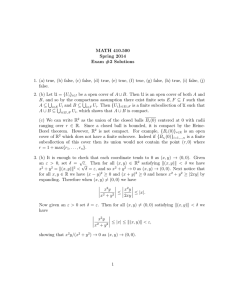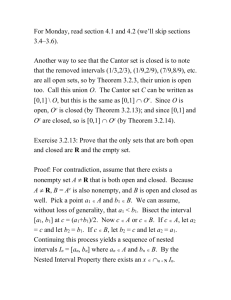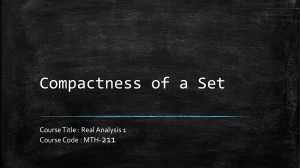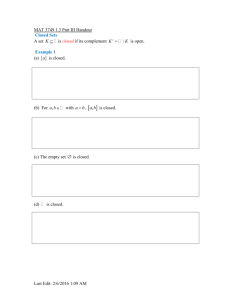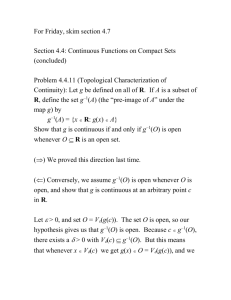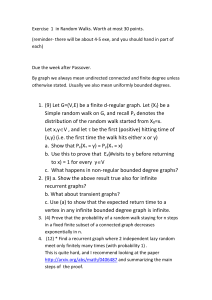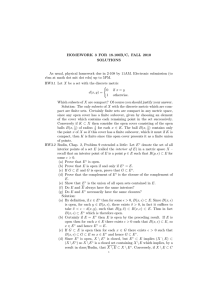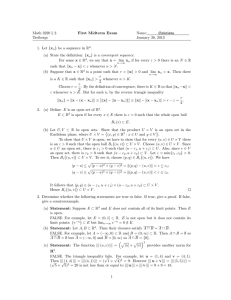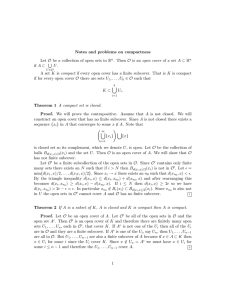Compact Sets (concluded). Review.
advertisement
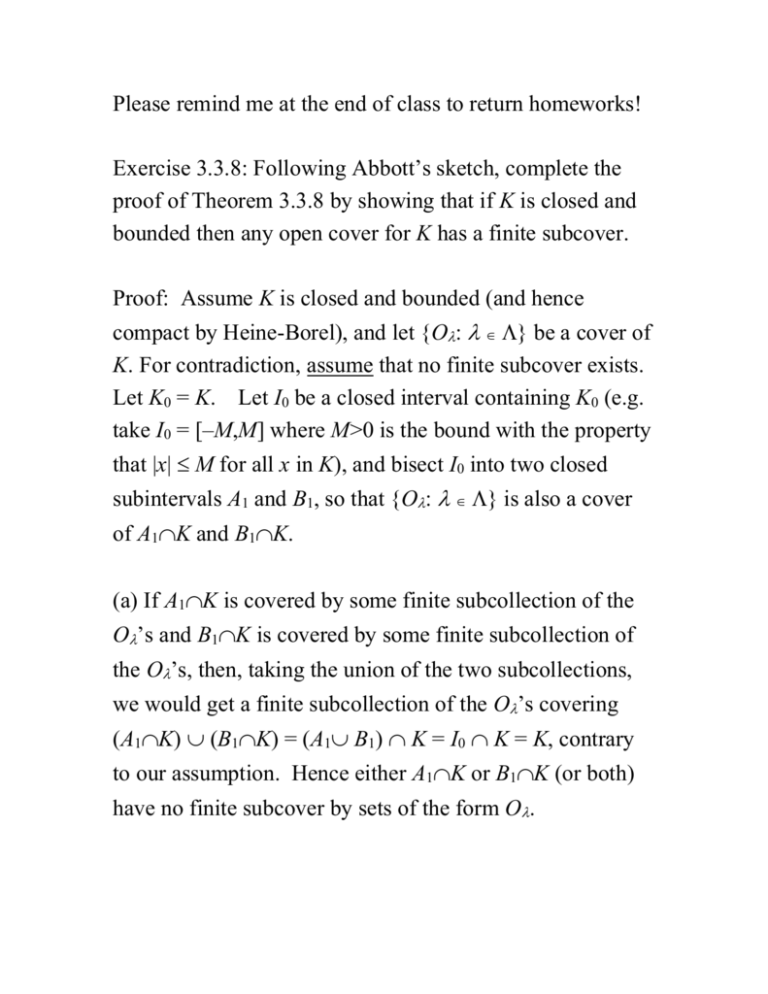
Please remind me at the end of class to return homeworks!
Exercise 3.3.8: Following Abbott’s sketch, complete the
proof of Theorem 3.3.8 by showing that if K is closed and
bounded then any open cover for K has a finite subcover.
Proof: Assume K is closed and bounded (and hence
compact by Heine-Borel), and let {O: } be a cover of
K. For contradiction, assume that no finite subcover exists.
Let K0 = K. Let I0 be a closed interval containing K0 (e.g.
take I0 = [–M,M] where M>0 is the bound with the property
that |x| M for all x in K), and bisect I0 into two closed
subintervals A1 and B1, so that {O: } is also a cover
of A1K and B1K.
(a) If A1K is covered by some finite subcollection of the
O’s and B1K is covered by some finite subcollection of
the O’s, then, taking the union of the two subcollections,
we would get a finite subcollection of the O’s covering
(A1K) (B1K) = (A1 B1) K = I0 K = K, contrary
to our assumption. Hence either A1K or B1K (or both)
have no finite subcover by sets of the form O.
(b) Let I1 be a half of I0 (either A1 or B1) whose intersection
with K does not have a finite subcover, so that K1 := I1K
cannot be finitely covered by O’s and I1 I0. Then bisect
I1 into two closed intervals, A2 and B2, and again let I2 be
either A2 or B2, making our choice so as to ensure that the
set K2 = I2K cannot be covered by finitely many O’s.
Continuing this process of bisecting the interval In, we get a
nested sequence of intervals I0 I1 I2 … with the
property that for each n,
(*) the set Kn := InK cannot be finitely covered by O’s,
and with the property that lim |In| = 0 (here |In| denotes the
length of In).
(c) Because K is compact, Kn = InK is also compact for
each n N. Note that the sets Kn are nested: K0 K1 K2
… By Theorem 3.3.5, nN Kn is nonempty, so there
exists an x that lies in Kn for all n.
(d) Let O be an open set from our original cover that
contains this x. Because O is open, there exists > 0 such
that V(x) O. Now choose n such that |In| < . Since x
In and |In| < , we have In V(x). (Check: If y In then
|y–x| |In| < , so y V(x).) Then In is contained in the
single open set O, and thus Kn In has a finite subcover.
This contradicts (*)!
This contradiction implies that K must have originally had
a finite subcover by sets O.
Questions on the sections covered up through the start of
class today?
Review problems:
Problems to try for Wednesday (on chapter 2 material):
1. Suppose x1 = 1 and xn+1 = xn + 1/xn for all n 1
(so that x2 = 2, x3 = 5/2, etc.) Does (xn) converge? Give a
rigorous proof of your answer.
2. Suppose xn 0 for all n N. If (xn) 0, show that
(sqrt(xn)) 0. (This is exercise 2.3.2(a).)
3. Suppose (xn) has the property that |xm – xn| < 1/m + 1/n
for all m,n. Prove that (xn) is Cauchy.
4. Prove or disprove: the sum of two bounded sequences
must be bounded.
5. Prove or disprove: the sum of two unbounded sequences
must be unbounded.
(Note that you’re also responsible for chapters 1 and 3.)
Review topic: partial sums
We say that the series a1 + a2 + a3 + … converges to the
sum S if and only if the partial sums sn = a1 + a2 + … + an
satisfy (sn) S.
Example: Does 1/2 + 1/6 + 1/12 + … + 1/n(n+1) + …
converge, and if so, to what?
an = 1/n(n+1)
sn = ?
Let’s look for a pattern and then worry about how to prove
it.
s1 = 1/2
s2 = 1/2 + 1/6 = 3/6 + 1/6 = 4/6 = 2/3
s3 = 2/3 + 1/12 = 8/12 + 1/12 = 9/12 = 3/4
We guess that …
…
(*) sn = n/(n+1).
We prove it by …
…
induction.
The formula (*) is true for n=1.
If the formula (*) is true for n, then
sn+1 = sn + an+1= n/(n+1) + 1/(n+1)(n+2) = (n+1)/(n+2)
(check that last equality: n(n+2) + 1 = (n+1)(n+1))
so the formula (*) is true for n+1.
Hence by induction (*) is true for all n 1.
So nN 1/n(n+1) = nN an = lim sn = lim n/(n+1) = 1.
How would we show that (n/(n+1)) 1 using the
definition of limits? …
…
Given any > 0, can we find an N such that for every
n N, |n/(n+1) – 1| < ? …
…
Take N 1/ (such an N is guaranteed to exist by …
the Archimedean Property).
Then for every n N we have |n/(n+1) – 1| = 1/(n+1) < 1/n
1/N < as required.
Note that it is possible for (an) to converge while (sn)
diverges. Example: (1/n) converges to 0 but the infinite
series nN 1/n diverges.
Claim: If (sn) converges, then (an) converges to 0. (This is
Theorem 2.7.3.)
Proof: If (sn) converges, then (sn) is Cauchy, so for all > 0
there exists N()N such that |sn – sm| < for all m,n N().
In particular, putting m = n–1 and noting that sn – sn–1 = an,
we see that |an| < for all n N()+1, so (an) 0.
For next time, find a different proof of Theorem 2.7.3 that
uses the Algebraic Limit Laws instead of the Cauchy
Criterion.

